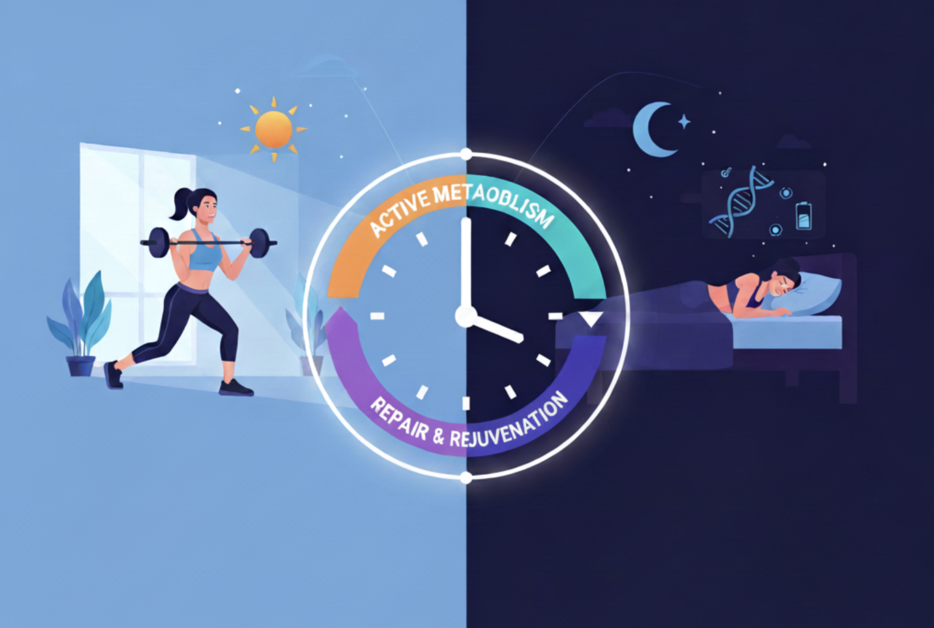Introduction
In 2025, fitness is no longer just about sets, reps, and calories burned. Scientists and trainers are looking deeper—into the body’s circadian rhythm, the natural 24-hour cycle that governs sleep, energy, hormone production, and recovery.
Aligning workouts, meals, and rest with your internal body clock has been shown to boost performance, speed recovery, and support long-term health. For busy Americans, this approach may hold the key to sustainable fitness progress.
What Is Circadian Rhythm?
Circadian rhythm is the internal biological clock that regulates:
- Sleep and wake cycles
- Hormone release (melatonin, cortisol, growth hormone)
- Core body temperature
- Cellular repair and recovery
These rhythms are influenced by light exposure, eating patterns, and daily routines. Disruptions—such as late-night screen use or irregular work hours—can reduce workout effectiveness and recovery.

Why Circadian Rhythm Matters for Fitness and Recovery
- Energy levels: Peaks and dips throughout the day affect exercise performance.
- Muscle recovery: Growth hormone release occurs mostly during deep sleep.
- Metabolism: Eating at misaligned times (late-night meals) can impair fat metabolism.
- Injury prevention: Training at times misaligned with natural alertness increases risk.
The Science: How the Body Clock Affects Performance
Studies show that:
- Reaction times and strength often peak in the late afternoon and early evening.
- Endurance performance may be better in the afternoon due to higher body temperature.
- Morning workouts are linked to better consistency and habit-building.
- Sleep deprivation reduces strength gains by up to 20% (NIH, 2024).
Morning vs. Evening Workouts: What Research Shows
| Factor | Morning Workouts | Evening Workouts |
|---|---|---|
| Consistency | Easier to stick to | Often disrupted by work/social plans |
| Fat burning | May improve fat oxidation | Less significant |
| Strength & Power | Slightly lower | Peak performance in evening |
| Sleep impact | Promotes earlier sleep | Late training can disrupt sleep |
Takeaway: Choose based on lifestyle and goals—morning for consistency, evening for peak strength.
Sleep, Hormones, and Muscle Recovery
Deep sleep stages are when:
- Growth hormone is released (key for muscle repair).
- Protein synthesis accelerates.
- Inflammation decreases, aiding recovery.
Poor sleep leads to higher cortisol, lower testosterone, and reduced muscle adaptation.

Blue Light, Technology, and Rhythm Disruption
Americans now spend more than 7 hours daily on screens (Pew Research, 2024). Blue light at night delays melatonin release, pushing circadian rhythm off track.
Actionable tips:
- Use blue light filters after sunset.
- Avoid screens 1–2 hours before bed.
- Try dim, warm lighting at night.
Nutrition Timing and Circadian Health
Nutrition is not just what you eat—it’s when.
- Eating late disrupts insulin sensitivity.
- Breakfast improves morning energy and workout readiness.
- Align meals with daylight hours for optimal metabolism.

Optimizing Training with Your Circadian Rhythm
1. Find Your Chronotype
- Morning types (“larks”): Perform best early in the day.
- Evening types (“owls”): Stronger in late afternoon/evening.
2. Align Workouts with Energy Peaks
- Morning: cardio, fat burning, consistency
- Afternoon: strength training, high intensity
- Evening: mobility, stretching, lighter activity
3. Prioritize Sleep Hygiene
- Aim for 7–9 hours of quality sleep.
- Keep a consistent sleep schedule.
4. Use Light to Reset Rhythm
- Get sunlight exposure within the first hour of waking.
- Dim lights at night to promote melatonin release.
Key Statistics for Americans in 2025
- 70% of U.S. adults report not getting enough quality sleep (CDC, 2024).
- Evening exercisers show a 15% higher strength output (Journal of Sports Science, 2023).
- Circadian disruption is linked to a 30% higher obesity risk (Harvard Health, 2024).
Expert Insights
Dr. Michael Lee, Sleep Researcher:
“Circadian alignment is the missing piece in most fitness programs. Without it, recovery and results suffer, no matter how hard you train.”
Coach Emily Davis, Certified Trainer:
“Understanding your personal body clock helps clients train smarter, not just harder. It’s a game-changer for sustainable progress.”
FAQ Section
Q1: Can night owls still train effectively?
Yes, align workouts to your natural rhythm. Evening types often thrive with late-afternoon strength sessions.
Q2: Does circadian rhythm affect fat loss?
Yes, misaligned eating and sleeping cycles reduce insulin sensitivity and slow fat metabolism.
Q3: Can supplements fix circadian disruption?
Not entirely. Melatonin may help, but lifestyle adjustments—light, sleep, timing—are the foundation.
Authoritative Resources
Actionable Checklist
- Identify your chronotype (morning or evening).
- Schedule workouts based on energy peaks.
- Avoid late-night eating and heavy meals.
- Reduce blue light exposure after sunset.
- Prioritize 7–9 hours of consistent sleep.
- Get morning sunlight daily.
Conclusion & Call to Action
Circadian rhythm is the body’s hidden fitness coach. By syncing workouts, sleep, and nutrition with your internal clock, you can achieve better performance, faster recovery, and long-term health.
👉 Start today: Track your energy levels for a week, adjust your workout timing, and make sleep non-negotiable. Your body clock may be the most powerful tool in your fitness journey.


